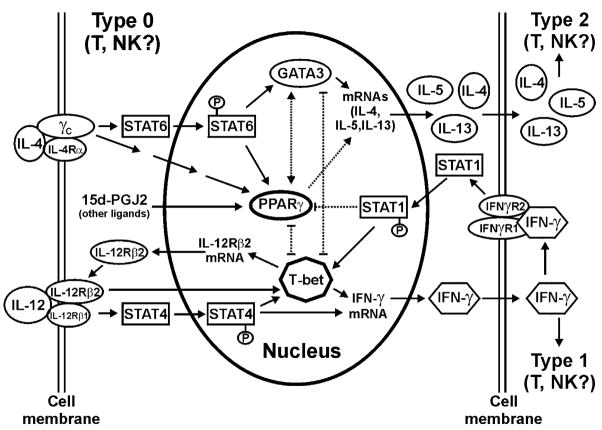Fig. 5.
PPAR-γ in Type 1/Type 2 T (NK) cell differentiation. Major molecular components involved in Type 1/Type 2 T (NK) cell differentiation are presented. The schematic diagram suggests several possible mechanisms by which PPAR-γ and its endogenous ligands favour Type 2 differentiation. Briefly, interaction of IL-4 with its cognate receptor will induce, either directly or indirectly through STAT6, the expression of genes such as GATA3 and PPAR-γ to increase the production of several cytokines including IL-4 itself, IL-5, and IL-13. These cytokines drive cell differentiation to Type 2 phenotype. Meanwhile, GATA3 and PPAR-γ may also negatively regulate the expression of genes critical for Type 1 differentiation such as T-bet. Binding of IL-12 with its surface receptor triggers activation of a JAK2/STAT4 cascade leading to IFN-γ gene expression. T-bet is the transcription factor whose expression is essential for IFN-γ gene expression in CD4+ T cells and NK cells. Whether T-bet is the downstream target for JAK2/STAT4 pathway remains to be determined. Expression of IFN-γ gene is a hallmark of Type 1 differentiation. Secreted IFN-γ binds to its surface receptor to initiate a JAKs/STAT1 signalling cascade, which promotes ubiquitin–proteasome-mediated PPAR-γ degradation. Thus, reduction of IFN-γ will help maintain the level of PPAR-γ. Meanwhile, PPAR-γ ligands can also block the production of IL-12. Together, the outcomes will favour Type 2 T and/or NK cell differentiation.

